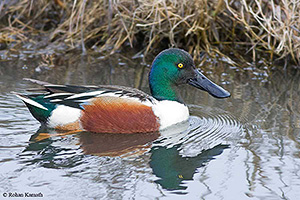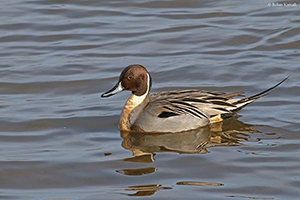Metallic Poisons |
|
|---|---|

 photographs of a Northern Shoveler and a Pintail by Rohan Kamath |
Hunters
annually kill millions of ducks and geese intentionally with
shotguns. Sadly, they also kill a large number of these
birds accidentally. Lead pellets that do not end up in the
hunters' targets plummet into ponds, lakes, and marshes
where they are often ingested by aquatic birds. It has been
estimated that 1400 pellets (about half a pound) are left
behind for every bird carried out. A single pellet swallowed
with food or taken as grit and ground in the gizzard can
introduce enough lead into the bloodstream to kill a duck.
Such poisoning of birds by lead ingestion has occurred on a
large scale -- over 100,000 Mallards died in Illinois in
1948; more than 500 Whistling Swans were killed in a North
Carolina refuge in 1974. In all some 1.5 to 3 million
waterfowl die from lead poisoning annually. Since 1980 more
than sixty Bald Eagles, which prey on waterfowl, have
acquired the poison from them and have also died. Mallards, Northern Pintails, Redheads, Ring-necked Ducks, Canvasbacks, Lesser Scaups and Canada Geese seem to suffer the heaviest mortality because they eat hard seeds and grains similar in appearance to lead shot, because they dig with their bills for tubers and seeds of aquatic vegetation in areas where the pellets are lodged, or (as in the Mallard) have high carbohydrate diets. Northern Shovelers, Blue-winged Teal, Green-winged Teal, and Wood Ducks all take softer food, forage without digging, or have high protein diets, and have lower mortality rates. Poisoned waterfowl show characteristic behaviors, including holding wings in a "roof-shaped" or drooped position, a walking with staggering gait, showing reluctance to fly, seeking isolation, or remaining behind after others migrate. |
| In the United States, the
lead poisoning problem has become sufficiently serious for
the Fish and Wildlife Service to announce a gradual ban on
lead shot beginning in the 1987-88 season, making its use
illegal in the United States by 1991. Steel substitutes are
not as desirable from the point of view of ballistics and
shotgun barrel wear, however, and it is not clear whether
the ban will be instituted. Clearly, it is in the interest
of both birders and hunters that this problem be resolved.
Weights used by anglers also cause lead poisoning of
waterfowl, but probably have minor impact in comparison with
lead shot. Although lead is the major metallic toxin threatening North American bird populations, mercury is another source of poisoning. It may be ingested by eating contaminated fish or along with seeds that have been treated with pesticides containing the element. The use of organic mercury pesticides on rice fields was responsible for extirpating White Storks from Japan; substantial mercury pollution of lakes and streams already exists on our continent, adding to the serious stresses already placed on bird populations by other human activities. |
|
| SEE:
DDT and Birds;
Disease and Parasitism. Copyright ® 1988 by Paul R. Ehrlich, David S. Dobkin, and Darryl Wheye. |
|